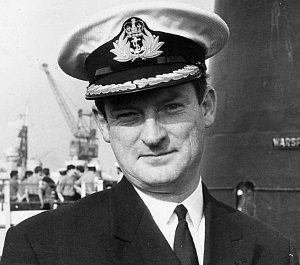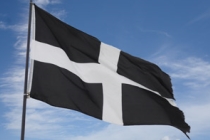Admiral Sir John Forster ‘Sandy’ Woodward GBE KCB - Admiral who commanded the British Naval Task Force 317.8 in the South Atlantic during the Falklands War.

Woodward was born on 1 May 1932 at Penzance, Cornwall, to a local bank clerk and his Cornish family.
Having graduated from the Royal Naval College Dartmouth, Woodward joined the Royal Navy in 1946.
He became a submariner in 1954, and was promoted to lieutenant that May.
In 1960 he passed the Royal Navy's rigorous Submarine Command Course known as The Perisher, and received his first command, the T Class submarine HMS Tireless.
Promoted to lieutenant-commander in May 1962, he then commanded HMS Grampus before becoming the second in command of the nuclear fleet submarine HMS Valiant.
In 1967, he was promoted to Commander and became the Instructor (known as Teacher) of The Perisher Course. He took command of HMS Warspite in December 1969. He was promoted to the rank of Captain in 1972. In 1974, he became Captain of Submarine Training and in 1976 he took command of HMS Sheffield.
He became Head of Naval Plans in the Ministry of Defence in 1978. In July 1981, he was promoted to Rear Admiral and appointed as Flag Officer First Flotilla.
In 1982, he commanded the Hermes aircraft carrier group, Task Force 317.8, in the Falklands War under the Commander-in-Chief Admiral Sir John Fieldhouse. (The task force containing the amphibious ships which launched the actual invasion TF 317.0 was commanded by Commodore Michael Clapp, with Task Force 317.1 being the landing force itself.)
He worked out the timetable for the campaign, starting from the end and working to the start.
Knowing that the Argentine forces had to be defeated before the (Southern Hemisphere) winter made conditions too bad, set a latest date by which the land forces had to be ashore, that in turn set a latest date by which control of the air was achieved, and so on.
Possibly the best known single incident was the sinking of the ARA General Belgrano. He knew that Belgrano (and particularly her Exocet armed escorts) were a threat to the task force and he ordered that Belgrano be sunk Admiral Sir George Zambellas credited ‘Woodward's inspirational leadership and tactical acumen ... [as] a major factor in shaping the success of the British forces in the South Atlantic’.
For his efforts during the war Woodward was knighted. His book One Hundred Days, co-authored by Patrick Robinson, describing his Falklands experiences, is a candid account of the pressures of high command in wartime and the impact on the individual commander.
In 1983, Woodward was appointed Flag Officer Submarines and NATO Commander Submarines Eastern Atlantic.
In 1984, he was promoted to Vice Admiral, and in 1985 he was Deputy Chief of the Defence Staff (Commitments). Before retirement in 1989 he also served, from 1987, as Commander-in-Chief Naval Home Command and Flag Aide-de-Camp to the Queen.
The first edition of Woodward's memoirs were published in 1992. They were well received and were updated in 2003 and 2012 with updated recollections as well as responses to the memoirs and responses made by Commodore Michael Clapp. In his later life Woodward wrote various opinion pieces for British newspapers regarding defence matters, particularly the Strategic Defence and Security Review.
Woodward married, in 1960, Charlotte McMurtrie (with whom he had a son and a daughter), but in 1993 they separated.
Sandy Woodward often returned home to Cornwall and holidayed there. He always made sure that local Cornish folk were invited to civic functions aboard naval ships visiting Cornish ports including visits by the Royal Yacht Britannia.
Woodward died of heart attack on 4 August 2013.
Photographs show Admiral Woodward and his taking of the Argentinian surrender of South Georgia from Captain Alfredo Astiz, the so called 'Blonde Angel of Death'.
This article has been kindly provided by Kernow Matters to Us and is part of the series on Famous Folk of Kernow (Cornwall).
- Cornish
- English
- Log in to post comments





